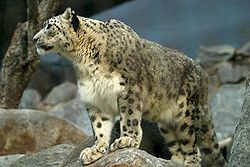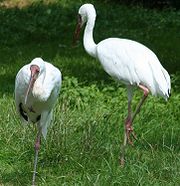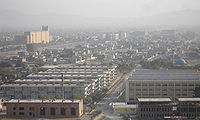
Environmental issues in Afghanistan
Encyclopedia

Grazing
Grazing generally describes a type of feeding, in which a herbivore feeds on plants , and also on other multicellular autotrophs...
and farming, practices which have only increased with modern population growth. In Afghanistan, environmental conservation and economic concerns are not at odds; with 80% of the population dependent on herding
Herding
Herding is the act of bringing individual animals together into a group , maintaining the group and moving the group from place to place—or any combination of those. While the layperson uses the term "herding", most individuals involved in the process term it mustering, "working stock" or...
or farming, the welfare of the environment is critical to the economic welfare of the people. In 2007, the World Health Organization
World Health Organization
The World Health Organization is a specialized agency of the United Nations that acts as a coordinating authority on international public health. Established on 7 April 1948, with headquarters in Geneva, Switzerland, the agency inherited the mandate and resources of its predecessor, the Health...
released a report ranking Afghanistan lowest among non-African nations in deaths from environmental hazards.
Deforestation
The population depends on forests for firewoodFirewood
Firewood is any wood-like material that is gathered and used for fuel. Generally, firewood is not highly processed and is in some sort of recognizable log or branch form....
and the revenue generated by export of pistachio
Pistachio
The pistachio, Pistacia vera in the Anacardiaceae family, is a small tree originally from Persia , which now can also be found in regions of Syria, Lebanon, Turkey, Greece, Kyrgyzstan, Turkmenistan, India, Pakistan, Egypt, Sicily and possibly Afghanistan , as well as in the United States,...
s and almond
Almond
The almond , is a species of tree native to the Middle East and South Asia. Almond is also the name of the edible and widely cultivated seed of this tree...
s, which grow in natural woodlands in the central and northern regions. The Badghis
Badghis Province
Bādghīs is one of the thirty-four provinces of Afghanistan. It is located in northwestern Afghanistan, between the Murghab and Hari rivers, extending as far northward as the edge of the desert of Sarakhs. It includes the Chul formations through which the Turkmen-Afghan boundary runs...
and Takhar
Takhar Province
Takhār is one of the thirty-four provinces of Afghanistan. It was established in 1964 when Qataghan Province was divided into three provinces: Baghlan, Kunduz and Takhar. It is in the north-east of the country. Its capital is Taloqan. Its salt mines are one of Afghanistan's major mineral resources...
provinces have lost more than 50% of pistachio woodland. During the conflicts of the past few decades, residents and military forces have used wood for fuel, and the military forces have cleared trees which could have provided hiding places for ambushes from opposing forces. Further, the use of the woodlands for grazing ground and the collection of nuts for export apparently prevent new pistachio trees from growing.
Denser forests in the eastern Nangarhar
Nangarhar Province
Nangarhar is one of the 34 provinces of Afghanistan in the east of the country. Its capital is the city of Jalalabad. The population of the province is 1,334,000, which consists mainly of ethnic Pashtuns with a sizable community of Arabs and Pashais....
, Kunar
Kunar Province
Kunar is one of the 34 provinces of Afghanistan, located in the northeastern part of the country. Its capital is Asadabad. It is one of the four "N2KL" provinces...
and Nuristan provinces are at risk from timber
Timber
Timber may refer to:* Timber, a term common in the United Kingdom and Australia for wood materials * Timber, Oregon, an unincorporated community in the U.S...
harvesting by timber barons. Although the logging
Logging
Logging is the cutting, skidding, on-site processing, and loading of trees or logs onto trucks.In forestry, the term logging is sometimes used in a narrow sense concerning the logistics of moving wood from the stump to somewhere outside the forest, usually a sawmill or a lumber yard...
is illegal, profits from exporting the timber abroad are very high.
As forest cover decreases, the land becomes less productive, threatening the livelihood of the rural population. Loss of vegetation also creates a higher risk of floods, which not only endanger the people, but cause soil erosion and decrease the amount of land available for agriculture
Agriculture
Agriculture is the cultivation of animals, plants, fungi and other life forms for food, fiber, and other products used to sustain life. Agriculture was the key implement in the rise of sedentary human civilization, whereby farming of domesticated species created food surpluses that nurtured the...
.
Wildlife
With very little government infrastructure to discourage huntingHunting
Hunting is the practice of pursuing any living thing, usually wildlife, for food, recreation, or trade. In present-day use, the term refers to lawful hunting, as distinguished from poaching, which is the killing, trapping or capture of the hunted species contrary to applicable law...
, and habitat disappearing because of conflict and drought, much of the country’s wildlife is at risk. In 2006, Afghanistan and the Wildlife Conservation Society
Wildlife Conservation Society
The Wildlife Conservation Society based at the Bronx Zoo was founded in 1895 as the New York Zoological Society and currently manages some of wild places around the world, with over 500 field conservation projects in 60 countries, and 200 scientists on staff...
began a three-year project to protect wildlife and habitats along the Wakhan Corridor
Wakhan Corridor
Wakhan Corridor is commonly used as a synonym for Wakhan, an area of far north-eastern Afghanistan which forms a land link or "corridor" between Afghanistan and China. The Corridor is a long and slender panhandle or salient, roughly long and between wide. It separates Tajikistan in the north...
and Central Plateau regions.


- Endangered speciesEndangered speciesAn endangered species is a population of organisms which is at risk of becoming extinct because it is either few in numbers, or threatened by changing environmental or predation parameters...
- Snow leopardSnow LeopardThe snow leopard is a moderately large cat native to the mountain ranges of South Asia and Central Asia...
(Uncia uncia) - Wild goatWild GoatThe wild goat is a widespread species of goat, with a distribution ranging from Europe and Asia Minor to central Asia and the Middle East. It is the ancestor of the domestic goat.-Social structure:...
(Capra aegagrus) - MarkhorMarkhorThe Markhor is a large species of wild goat that is found in northeastern Afghanistan, Pakistan , India, southern Tajikistan and southern Uzbekistan...
(Capra falconeri) - Marco Polo sheepMarco Polo sheepThe Marco Polo sheep is a subspecies of argali sheep, named after Marco Polo. Their habitat is the mountainous regions of Central Asia. Marco Polo sheep are distinguishable mostly by their large size and spiraling horns. Their conservation status is "near threatened" and efforts have been made to...
(Ovis ammon polii) - UrialUrialThe Urial , also known as the Arkars or Shapo, is a subspecies group of the wild sheep Ovis orientalis. Noticeable features are the reddish-brown long fur that fades during winter; males are characterized by a black ruff stretching from the neck to the chest and large horns. It is found in western...
(Ovis orientalis) - Asiatic black bearAsiatic Black BearThe Asian black bear , also known as the moon bear or white-chested bear is a medium-sized species of bear, largely adapted for arboreal life, which occurs through much of southern Asia, Korea, northeastern China, the Russian far east and Honshū and Shikoku islands of Japan...
(Ursus thibetanus) - Siberian craneSiberian CraneThe Siberian Crane also known as the Siberian White Crane or the Snow Crane, is a bird of the family Gruidae, the cranes...
(Grus leucogeranus)
- Snow leopard
- Critically endangered species
- White-headed duckWhite-headed DuckThe White-headed Duck is a small stiff-tailed duck.Adult males have a grey and reddish body, a blue bill and a largely white head with a black cap and neck. Adult females have a grey-brown body with a white face and a darker bill, cap and a cheek stripe.This duck breeds in Spain and North Africa,...
(Oxyura leucocephala) - Marbled teal (Marmaronetta angustirostris)
- Pallas’s sea eaglePallas's Sea EaglePallas's Fish Eagle , also known as Pallas's Sea Eagle or Band-Tailed Fish Eagle, is a large, brownish sea-eagle. It breeds in Central Asia, between the Caspian Sea and the Yellow Sea, from Kazakhstan and Mongolia to the Himalayas, Bangladesh and northern India...
(Haliaeetus leucoryphus) - Greater spotted eagleGreater Spotted EagleThe Greater Spotted Eagle , occasionally just called the spotted eagle, is a large bird of prey. Like all typical eagles, it belongs to the family Accipitridae...
(Aquilla clanga) - Imperial eagleImperial EagleAn Imperial Eagle is a heraldic eagle used by an empire, notably:*the military standard of the Roman Empire, see Aquila .*the Byzantine imperial eagle*the German Reichsadler...
(Aquilla heliaca) - Lesser kestrelLesser KestrelThe Lesser Kestrel is a small falcon. This species breeds from the Mediterranean across southern central Asia to China and Mongolia. It is a summer migrant, wintering in Africa and Pakistan and sometimes even to India and Iraq. It is rare north of its breeding range, and declining in its European...
(Falco naumanni) - Corncrake (Crex crex)
- Sociable lapwingSociable LapwingThe Sociable Lapwing or Sociable Plover is a wader in the lapwing family of birds.It breeds on open grassland in Russia and Kazakhstan. Three to five eggs are laid in a ground nest...
(Vanellus gregaria) - Pale-backed pigeonPale-backed PigeonThe Yellow-eyed Pigeon or Pale-backed Pigeon is a member of the family Columbidae . It breeds in southern Kazakhstan, Uzbekistan, Turkmenistan, Tajikistan, Kyrgystan, Afghanistan, north-east Iran and extreme north-west China...
(Columba hodgsonii)
- White-headed duck
Little is known about the status of the salamander
Salamander
Salamander is a common name of approximately 500 species of amphibians. They are typically characterized by a superficially lizard-like appearance, with their slender bodies, short noses, and long tails. All known fossils and extinct species fall under the order Caudata, while sometimes the extant...
Batrachuperus mustersi, which is found only in the Hindu Kush
Hindu Kush
The Hindu Kush is an mountain range that stretches between central Afghanistan and northern Pakistan. The highest point in the Hindu Kush is Tirich Mir in the Chitral region of Khyber-Pakhtunkhwa, Pakistan.It is the westernmost extension of the Pamir Mountains, the Karakoram Range, and is a...
.
Water management
Today, the primary threat to Afghanistan's water supply is the droughts from 1998-2003 and 2006, which created food shortages for millions. The resulting agricultural crises throughout central Afghanistan have driven major migrations from rural to urban areas.In response to drought, deep wells have been drilled, further draining groundwater resources, which rely on rain for replenishment. By 2003, 99% of the Sistan
Sistan
Sīstān is a border region in eastern Iran , southwestern Afghanistan and northern tip of Southwestern Pakistan .-Etymology:...
wetlands were dry, another result of continued drought and lack of water management
Water management
Water management is the activity of planning, developing, distributing and managing the optimum use of water resources. In an ideal world. water management planning has regard to all the competing demands for water and seeks to allocate water on an equitable basis to satisfy all uses and demands...
. The wetlands, an important habitat for breeding and migrant waterfowl including the dalmatian pelican
Dalmatian Pelican
The Dalmatian Pelican is a member of the pelican family. It breeds from southeastern Europe to India and China in swamps and shallow lakes. The nest is a crude heap of vegetation....
and the marbled teal, have provided water for agricultural irrigation
Irrigation
Irrigation may be defined as the science of artificial application of water to the land or soil. It is used to assist in the growing of agricultural crops, maintenance of landscapes, and revegetation of disturbed soils in dry areas and during periods of inadequate rainfall...
for at least 5000 years. They are fed by the Helmand River
Helmand River
The Helmand River is the longest river in Afghanistan and the primarily watershed for the endorheic Sistan Basin....
, which ran at 98% below average in drought years 2001-2003. As in other areas of the country, the loss of natural vegetation resulted in soil erosion; here, sandstorms submerged as many as 100 villages by 2003.
Major water reservoirs
Reservoir
A reservoir , artificial lake or dam is used to store water.Reservoirs may be created in river valleys by the construction of a dam or may be built by excavation in the ground or by conventional construction techniques such as brickwork or cast concrete.The term reservoir may also be used to...
and dam
Dam
A dam is a barrier that impounds water or underground streams. Dams generally serve the primary purpose of retaining water, while other structures such as floodgates or levees are used to manage or prevent water flow into specific land regions. Hydropower and pumped-storage hydroelectricity are...
s include the following:
- Lake QarghaLake QarghaQargha is a lake and reservoir in Afghanistan, just 9 km from Kabul....
- Band-e AmirBand-e AmirBand-e Amir is a series of six deep blue lakes separated by natural dams made of travertine, a mineral deposit. The lakes are situated in the Hindu Kush Mountains of Central Afghanistan at approximately 3000 meters of elevation, west of the famous Buddhas of Bamiyan.They were created by the carbon...
- Dahla DamDahla DamThe Dahla Dam is the largest dam in Kandahar Province, and the second largest in Afghanistan.The dam is 34 kilometers north of Kandahar City.The dam was first built between 1950 to 1952 during the reign of Zahir Shah, the last King of Afghanistan....
- Darunta DamDarunta DamThe Darunta Dam is a hydroelectric power dam located on the Kabul River, approximately 7 km west of Jalalabad, the capital of Nangarhar Province in eastern Afghanistan....
- Kajaki Dam
- Salma DamSalma DamSalma Dam is an under construction hydroelectric and irrigation dam project located on the Hari River in Chishti sharif District of Herat Province in western Afghanistan....
Urban pollution
Urban populations have swelled in the past several years. Migrants have come from drought-ravaged rural areas, and around 1.8 million refugees returned to the country (over 500,000 to KabulKabul
Kabul , spelt Caubul in some classic literatures, is the capital and largest city of Afghanistan. It is also the capital of the Kabul Province, located in the eastern section of Afghanistan...
alone) after the fall of the Taliban government in 2002.
Domestic and industrial waste

United Nations
The United Nations is an international organization whose stated aims are facilitating cooperation in international law, international security, economic development, social progress, human rights, and achievement of world peace...
Environmental Program found that a lack of waste management systems was creating dangerous conditions in several urban areas. In Kabul’s districts 5 and 6, household and medical waste was discarded on streets. Human waste was contained in open sewers, which flowed into the Kabul River
Kabul River
Kabul River , the classical Cophes , is a 700 km long river that starts in the Sanglakh Range of the Hindu Kush Mountains in Afghanistan and ends in the Indus River near Attock, Pakistan. It is the main river in eastern Afghanistan and is separated from the watershed of the Helmand by the Unai Pass...
and contaminated the city’s drinking water.
Urban dumpsites are used in lieu of managed landfills in Kabul, Kandahar
Kandahar
Kandahar is the second largest city in Afghanistan, with a population of about 512,200 as of 2011. It is the capital of Kandahar Province, located in the south of the country at about 1,005 m above sea level...
and Herat
Herat
Herāt is the capital of Herat province in Afghanistan. It is the third largest city of Afghanistan, with a population of about 397,456 as of 2006. It is situated in the valley of the Hari River, which flows from the mountains of central Afghanistan to the Karakum Desert in Turkmenistan...
, often without protection of nearby rivers and groundwater supplies. Medical waste from hospitals is disposed in the dumpsites with the rest of the cities’ waste, contaminating water and air with bacteria
Bacteria
Bacteria are a large domain of prokaryotic microorganisms. Typically a few micrometres in length, bacteria have a wide range of shapes, ranging from spheres to rods and spirals...
and viruses.
Lack of sewage management is not unique to Kabul. In urban areas, open sewers are common while wastewater treatment is not. Much of the urban water supply is contaminated by Escherichia coli
Escherichia coli
Escherichia coli is a Gram-negative, rod-shaped bacterium that is commonly found in the lower intestine of warm-blooded organisms . Most E. coli strains are harmless, but some serotypes can cause serious food poisoning in humans, and are occasionally responsible for product recalls...
and other bacteria.
Oil refineries are another source of water contamination. In Herat and Mazar-e-Sharif, crude oil spills and leaks are uncontained and unsafe levels of hydrocarbon
Hydrocarbon
In organic chemistry, a hydrocarbon is an organic compound consisting entirely of hydrogen and carbon. Hydrocarbons from which one hydrogen atom has been removed are functional groups, called hydrocarbyls....
s reach residential water supplies.

